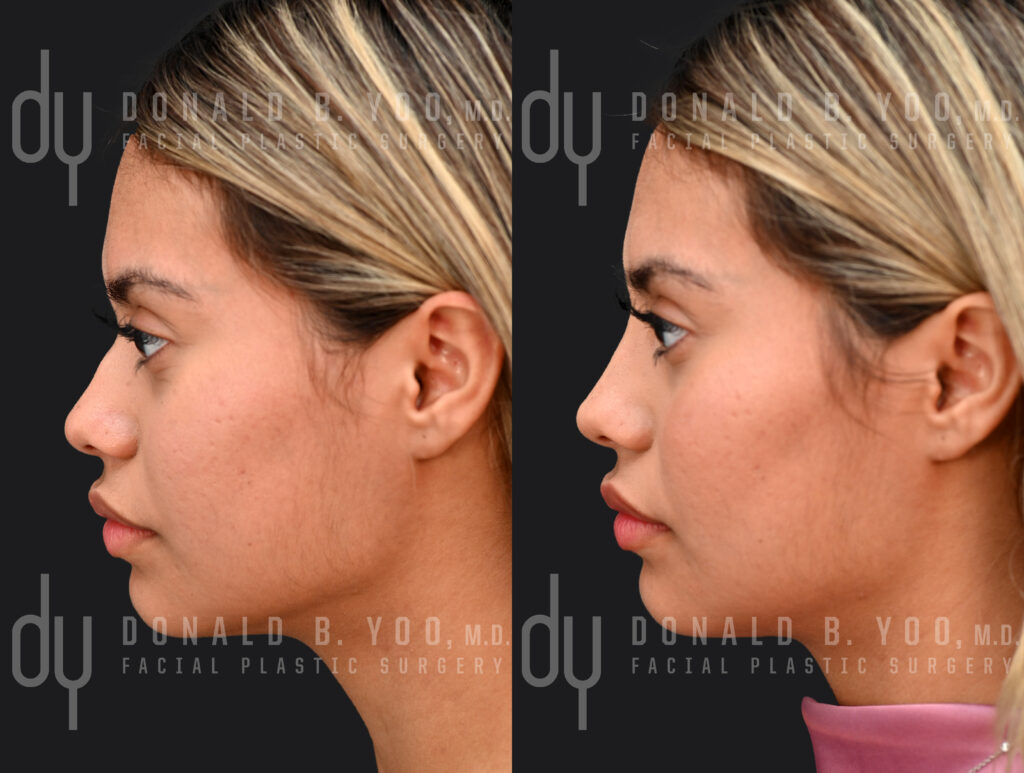Nonsurgical rhinoplasty, or liquid nose job, refers to the use of dermal fillers to change the shape of the nose. The past few decades have seen a rapid evolution in the development and application of facial fillers that offer safe, effective, and longer lasting results.
Though difficult to fathom now, the first injectable filler was actually paraffin wax. It predictably caused a number of serious complications, including delayed chronic granuloma formation, and its use abandoned. Silicone injections followed soon after, also with severe complications including scarring and granuloma formation, leading to a ban on its use by the U.S. FDA. While Silikon 1000 is a medical-grade silicone that is FDA approved for injection to treat retinal detachment, but some unscrupulous surgeons continue to inject silicone in delicate areas such as the nose, where irreversible injury in the form of scarring, fibrosis and granuloma formation occurs frequently.
A huge leap forward occurred with the development of bovine collagen for use as a dermal filler, and the FDA approved it for cosmetic injection in 1981. While an improvement on the previously available materials such as silicone and wax, the effects of bovine collagen were very short-lived – on the order of ~3 months. Also the cow origin of the protein led to a theoretical risk of allergic reaction that had to be tested for prior to injection, and monitored carefully after treatment.
Hyaluronic acid fillers ushered in the modern era of cosmetic filler injections with the FDA approval of Restylane in 2003. Hyaluronic acid occurs naturally in our skin and joints, conferring the characteristic elasticity and ability to retain water. Since it naturally occurs in our body, hyaluronic acid fillers also possess an extremely low theoretical risk of allergic reactions, and thus immunogenic testing is not required. Its stable composition, which allows it to be stored at room temperature and also last many times longer than bovine collagen once injected, has provided a seismic shift in the way surgeons perform cosmetic filler injections.
Advancements continue to improve upon the favorable characteristics of hyaluronic acid fillers for specific anatomic areas. A full armamentarium of facial fillers, from those with high cohesivity and resistance to deformation, to extremely soft and silky fillers. For nonsurgical rhinoplasty, the mainstay of safe and effective treatment remains hyaluronic acid fillers that have a high G prime and high cohesivity such as Restylane, Restylane Lyft and Juvederm Voluma. The cost of nonsurgical rhinoplasty typically differs depending on the type of filler used, in addition to the skill and experience of the surgeon performing the liquid nose job.
So what are the limitations? Nonsurgical rhinoplasty works great for issues that can be addressed and improved by adding volume. Surgeons can easily address minor asymmetries caused by depressions or lack of volume, augment the nasal dorsum or bridge in patients lacking height, camouflage mild to moderate dorsal humps by adding volume and height to the radix, slightly increase tip projection and definition, and create minor changes to the tip rotation either rotating or counter-rotating the tip. Within these parameters surgeons can enhance the shape of the nose fairly significantly, in the appropriately selected patients.

Nonsurgical nose job does not make a tall nose shorter, de-project a nasal tip that sticks out too far, reduce the width and flare of nostrils, reduce the width of wide nasal bones, straighten a deviated septum, or reduce excess volume in the tip of the nose. Especially in patients with thicker skin, changes to the tip of the nose may be limited given the mismatch between strong thick skin vs. weak underlying cartilaginous support. Detailed evaluation by a nonsurgical nose job specialist, followed by comprehensive discussion of the expected results, risks and limitations, will ensure the highest chance of the best and most beautiful result.
 Contact Us
Contact Us